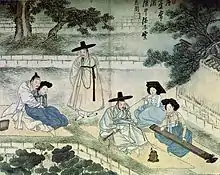Castes are largely hereditary social classes often emerging around certain professions. Lower castes are associated with professions considered "unclean", which has often included the sex industry. The term Caste-based prostitution,[1][2][3] or Intergenerational prostitution[4] is sometimes used to refer to when women of certain castes are traditionally involved in prostitution. Additionally, the vulnerable socio-economic status of lower caste women leads to a significant percentage of them entering sex work.[5]
Examples
India
It is estimated that a majority of prostitutes in India are of lower caste and a social activist speculated that in India, there might be an estimated 100,000 lower-caste women and girls work in prostitution.[6]
Lower caste groups associated with intergenerational prostitution include the Banchhada, the Bedias,[7] the Perna caste[8] and the Nat caste. It is believed that such groups were often nomadic in the past and settled into small villages, which were to be known as "Prostitute villages". During the colonial period, such groups were often classified as "criminal tribes" under the Criminal Tribes Act, and often lost their traditional sources of income, such as dancers, under the resulting persecution which forced the women to adopt prostitution.[9] Even though they are now termed Denotified and Nomadic Tribes of India (DNTs), they are still more commonly known to mainstream society as "Criminal Tribes".[10] This practice is most concentrated in the central Indian state of Madhya Pradesh.[11] Among the Bacchara, according to Monalika Tiwari, a social worker with the organization Jan Sahas, men are generally not expected to work, while at least one girl in most families is expected to become a prostitute instead of getting married.[2] Girls are married or enter sex work between 10 and 12,[1] and most turn into sex work before they are 18.[3] While boys are often preferred to girls in the country, with sex-selective abortions causing a skewed gender ratio, the birth of girls among some low-caste villages built around prostitution is celebrated as the arrival of future breadwinners. They are groomed by their own families into prostitution, often from birth, with reports of younger girls stowed under beds to observe others at work.[6] The younger the girl, the higher the price tends to be for sexual services.[11] Among the Perna caste, girls are married after puberty and are physically abused if they then resist going into prostitution by their in-laws, who expect their son's wife to contribute to the family finances.[10] Among the Bedia, girls are introduced to the profession soon as they reach puberty.[7]
Korea

In pre-modern Korea, the Kisaeng were women from the lower caste Cheonmin who were trained to provide entertainment, conversation, and sexual services to men of the upper class.[12]
Nepal
In Nepal, the Badi people are known to be traditionally involved with prostitution.[13][14] After the 14th century, the Badis received land and money for providing concubines to small-time rulers in western Nepal. After 1950, local royalty lost power in a pro-democracy movement. Thus, the Badis saw their clientele disappear, and they eventually turned to prostitution.[15]
References
- 1 2 "A Girl on the Highway". indianexpress.com. 2 July 2018. Retrieved 1 January 2021.
- 1 2 "She was forced into sex work. Now that she's left that behind, she dreams of being a doctor". Public Radio International. 27 February 2018. Retrieved 1 January 2021.
- 1 2 "This Road Leads to Sex Work". The Quint. 9 March 2020. Retrieved 1 January 2021.
- ↑ Dolson, A (2014). "Intergenerational Prostitution in India: How a Cultural Practice Constitutes Sex Trafficking". Women, Political Struggles and Gender Equality in South Asia: 83–95. doi:10.1057/9781137390578_6. ISBN 978-1-349-48267-2. Retrieved 4 August 2022.
- ↑ "Why India's Dalit women are vulnerable to sexual violence". Deutsche Welle. 28 October 2020. Retrieved 4 August 2022.
- 1 2 "The Indian village where child sexual exploitation is the norm". The Guardian. 14 January 2019. Retrieved 2 January 2021.
- 1 2 Rana, U., Sharma, D. & Ghosh, D. Prostitution in northern Central India: an ethnographical study of Bedia community. Int. j. anthropol. ethnol. 4, 2 (2020).
- ↑ "This Road Leads to Sex Work". Pacific Standard. 12 March 2018. Retrieved 2 January 2021.
- ↑ "Nat Purwa: Where prostitution is a tradition". Al Jazeera. 19 January 2013. Retrieved 2 January 2021.
- 1 2 "The Indian caste where wives are forced into sex work". Al Jazeera. 28 November 2016. Retrieved 2 January 2021.
- 1 2 ""India: The Child Sex Highway". Al Jazeera. 16 January 2020. Retrieved 2 January 2021.
- ↑ Cho, Grace (2008). Haunting the Korean Diaspora: Shame, Secrecy, and the Forgotten War. University of Minnesota Press. p. 103. ISBN 978-0816652754.
- ↑ "Nepal's Badi community finds itself in a bottomless pit of despair". Kathmandu Post. 23 January 2020. Retrieved 2 January 2021.
- ↑ "Caste System Binds Nepalese Prostitutes". The New York Times. 11 April 2004. Retrieved 2 January 2021.
- ↑ "Badi women of Nepal are trapped in a life of degradation". Los Angeles Times. 12 June 2011. Retrieved 2 January 2021.